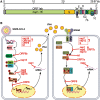Antagonism of Type I Interferon by Severe Acute Respiratory Syndrome Coronavirus 2
- PMID: 33337934
- PMCID: PMC7757701
- DOI: 10.1089/jir.2020.0214
Antagonism of Type I Interferon by Severe Acute Respiratory Syndrome Coronavirus 2
Abstract
The coronavirus disease 2019 (COVID-19) pandemic is caused by severe acute respiratory syndrome coronavirus 2 (SARS-CoV-2), warranting urgent study of the molecular mechanisms of SARS-CoV-2 infection and host immune response. Type I interferon (IFN-I) is a key component of host innate immune system responsible for eliminating the virus at the early stage of infection. In contrast, SARS-CoV-2 has evolved multiple strategies to evade innate immune response to facilitate viral replication, transmission, and pathogenesis. This review summarizes the recent progresses on SARS-CoV-2 proteins that antagonize host IFN-I production and/or signaling. These progresses have provided knowledge for new vaccine and antiviral development to prevent and control COVID-19.
Keywords: COVID-19; SARS-CoV-2; immune evasion; interferon.
Conflict of interest statement
No competing financial interests exist.
Figures

Similar articles
-
An Update on Innate Immune Responses during SARS-CoV-2 Infection.Viruses. 2021 Oct 14;13(10):2060. doi: 10.3390/v13102060. Viruses. 2021. PMID: 34696490 Free PMC article. Review.
-
N7-Methylation of the Coronavirus RNA Cap Is Required for Maximal Virulence by Preventing Innate Immune Recognition.mBio. 2022 Feb 22;13(1):e0366221. doi: 10.1128/mbio.03662-21. Epub 2022 Jan 25. mBio. 2022. PMID: 35073761 Free PMC article.
-
RIG-I-Like Receptor-Mediated Recognition of Viral Genomic RNA of Severe Acute Respiratory Syndrome Coronavirus-2 and Viral Escape From the Host Innate Immune Responses.Front Immunol. 2021 Jun 25;12:700926. doi: 10.3389/fimmu.2021.700926. eCollection 2021. Front Immunol. 2021. PMID: 34249006 Free PMC article.
-
SARS-CoV-2 Nonstructural Protein 1 Inhibits the Interferon Response by Causing Depletion of Key Host Signaling Factors.J Virol. 2021 Jun 10;95(13):e0026621. doi: 10.1128/JVI.00266-21. Epub 2021 Jun 10. J Virol. 2021. PMID: 34110264 Free PMC article.
-
Type I and III interferon responses in SARS-CoV-2 infection.Exp Mol Med. 2021 May;53(5):750-760. doi: 10.1038/s12276-021-00592-0. Epub 2021 May 6. Exp Mol Med. 2021. PMID: 33953323 Free PMC article. Review.
Cited by
-
Does Genetic Predisposition Contribute to the Exacerbation of COVID-19 Symptoms in Individuals with Comorbidities and Explain the Huge Mortality Disparity between the East and the West?Int J Mol Sci. 2021 May 8;22(9):5000. doi: 10.3390/ijms22095000. Int J Mol Sci. 2021. PMID: 34066804 Free PMC article. Review.
-
Obesity and Leptin Resistance in the Regulation of the Type I Interferon Early Response and the Increased Risk for Severe COVID-19.Nutrients. 2022 Mar 26;14(7):1388. doi: 10.3390/nu14071388. Nutrients. 2022. PMID: 35406000 Free PMC article. Review.
-
New insights into the pathogenesis of SARS-CoV-2 during and after the COVID-19 pandemic.Front Immunol. 2024 Jun 7;15:1363572. doi: 10.3389/fimmu.2024.1363572. eCollection 2024. Front Immunol. 2024. PMID: 38911850 Free PMC article. Review.
-
Severe Acute Respiratory Syndrome Coronavirus 2: The Emergence of Important Genetic Variants and Testing Options for Clinical Laboratories.Clin Microbiol Newsl. 2021 Jun 1;43(11):89-96. doi: 10.1016/j.clinmicnews.2021.05.004. Epub 2021 May 21. Clin Microbiol Newsl. 2021. PMID: 34035555 Free PMC article.
-
Efficacy of interferon alpha for the treatment of hospitalized patients with COVID-19: A meta-analysis.Front Immunol. 2023 Jan 26;14:1069894. doi: 10.3389/fimmu.2023.1069894. eCollection 2023. Front Immunol. 2023. PMID: 36776844 Free PMC article.
References
-
- Assiri A, Al-Tawfiq JA, Al-Rabeeah AA, Al-Rabiah FA, Al-Hajjar S, Al-Barrak A, Flemban H, Al-Nassir WN, Balkhy HH, Al-Hakeem RF, et al. . 2013. Epidemiological, demographic, and clinical characteristics of 47 cases of Middle East respiratory syndrome coronavirus disease from Saudi Arabia: a descriptive study. Lancet Infect Dis 13(9):752–761 - PMC - PubMed
-
- Balachandran S, Roberts PC, Brown LE, Truong H, Pattnaik AK, Archer DR, Barber GN. 2000. Essential role for the dsRNA-dependent protein kinase PKR in innate immunity to viral infection. Immunity 13(1):129–141 - PubMed
Publication types
MeSH terms
Substances
Grants and funding
LinkOut - more resources
Full Text Sources
Other Literature Sources
Medical
Miscellaneous
